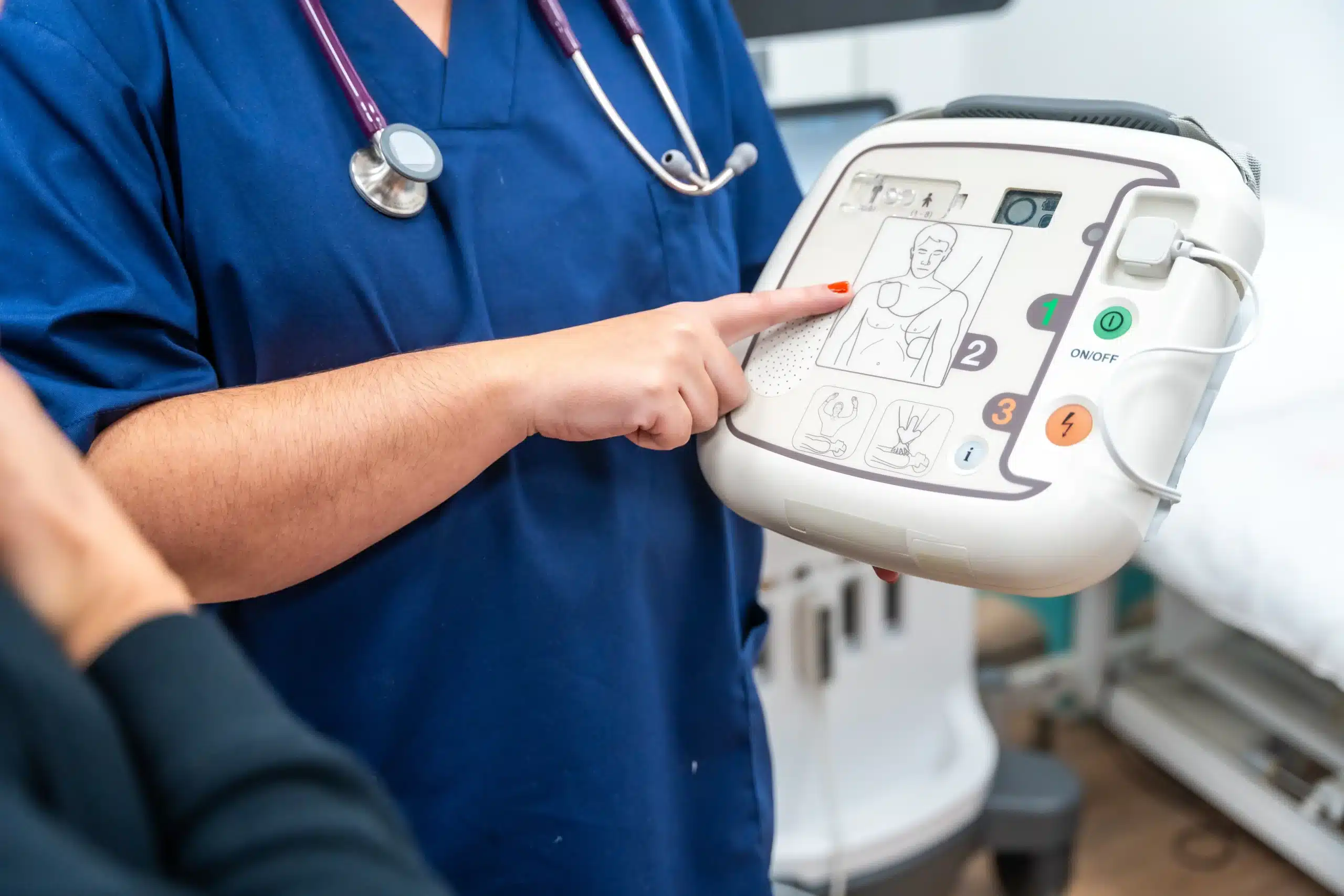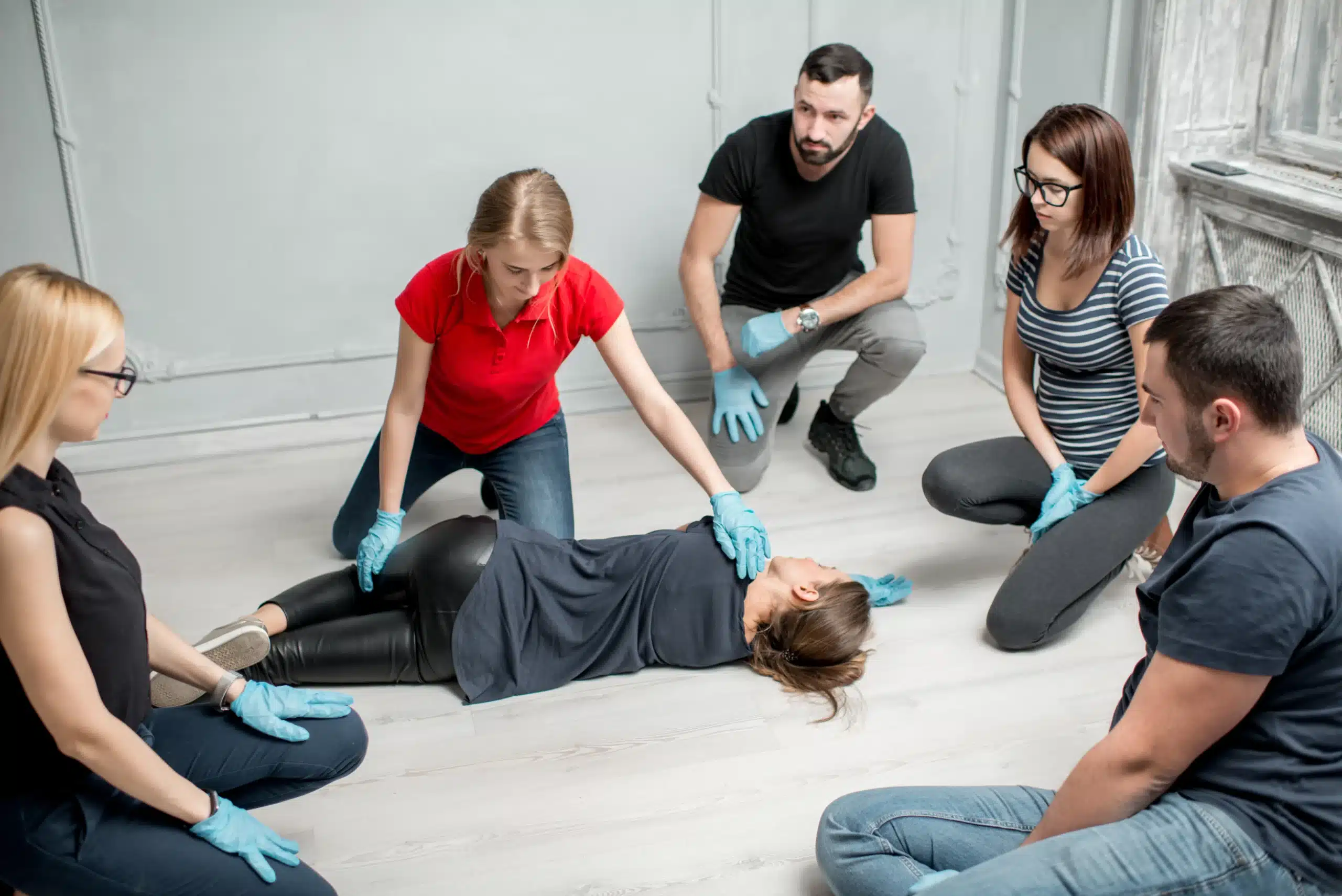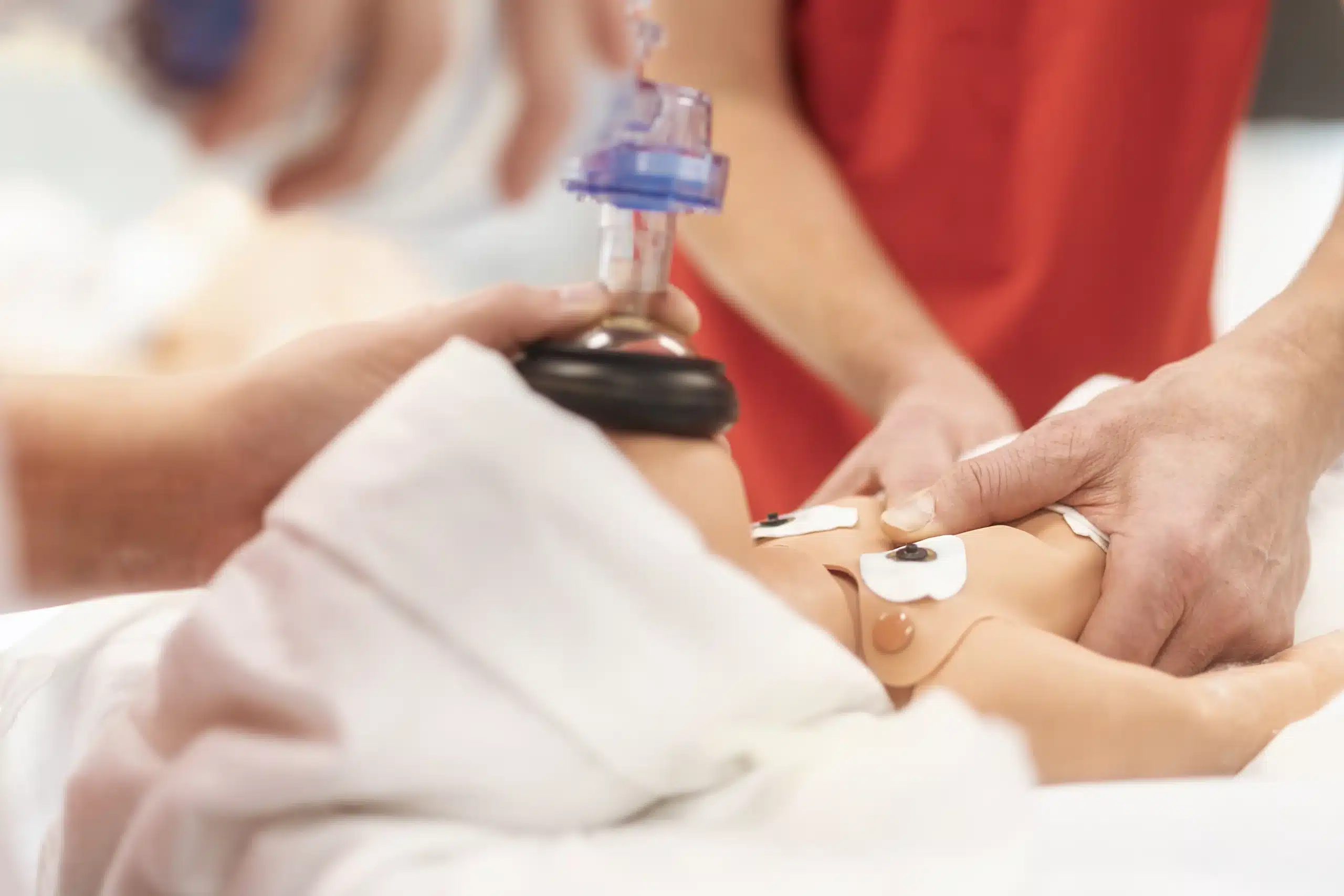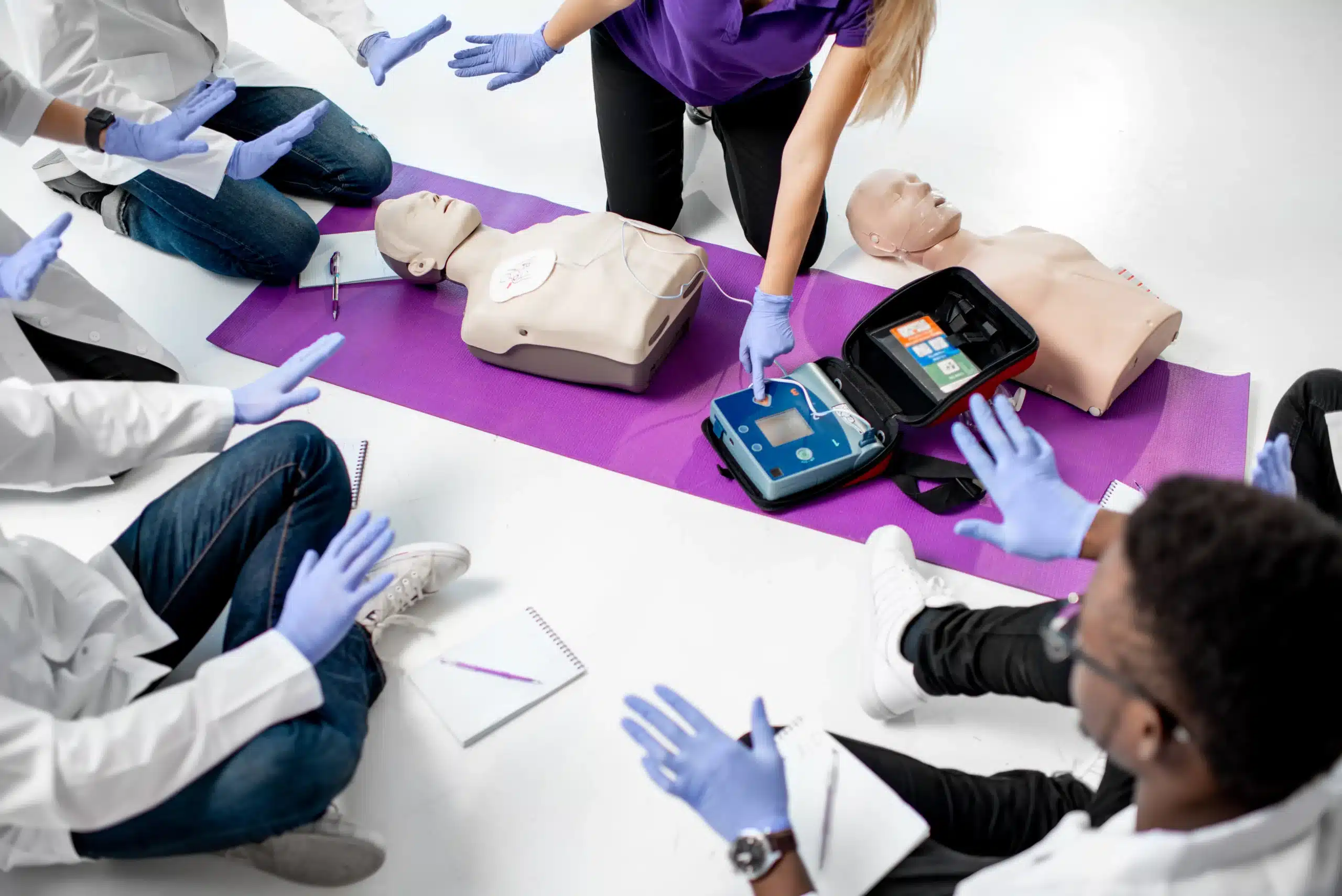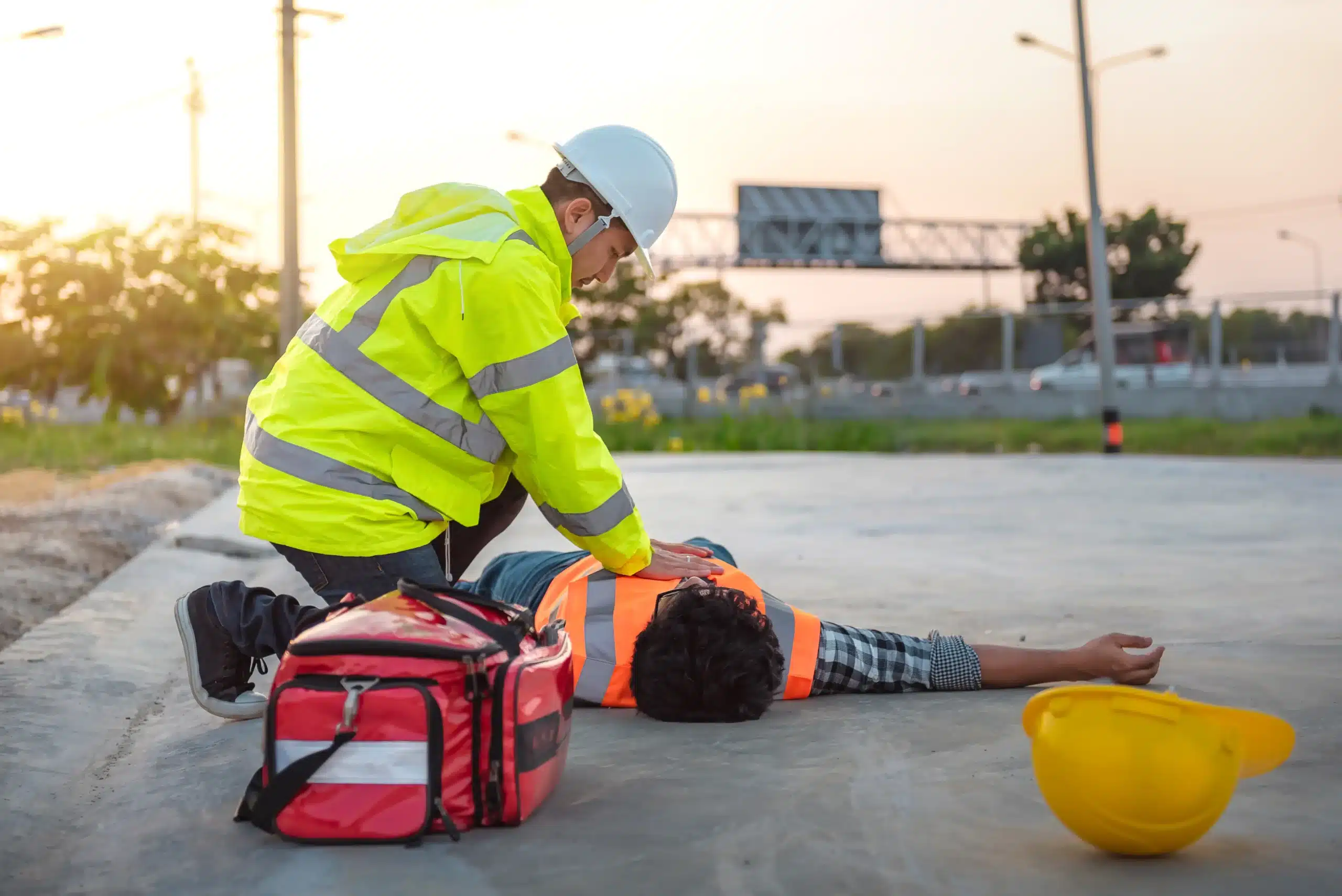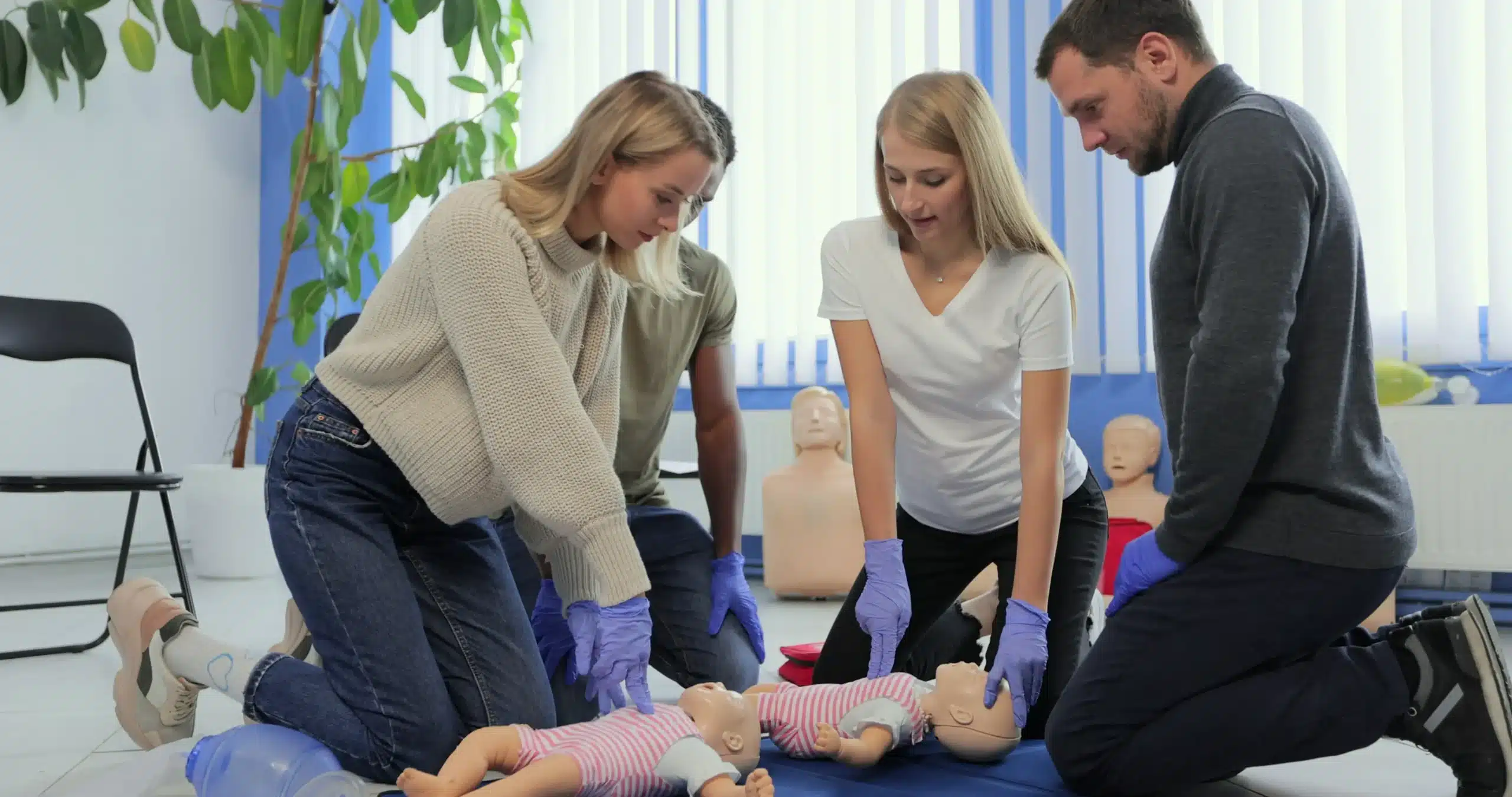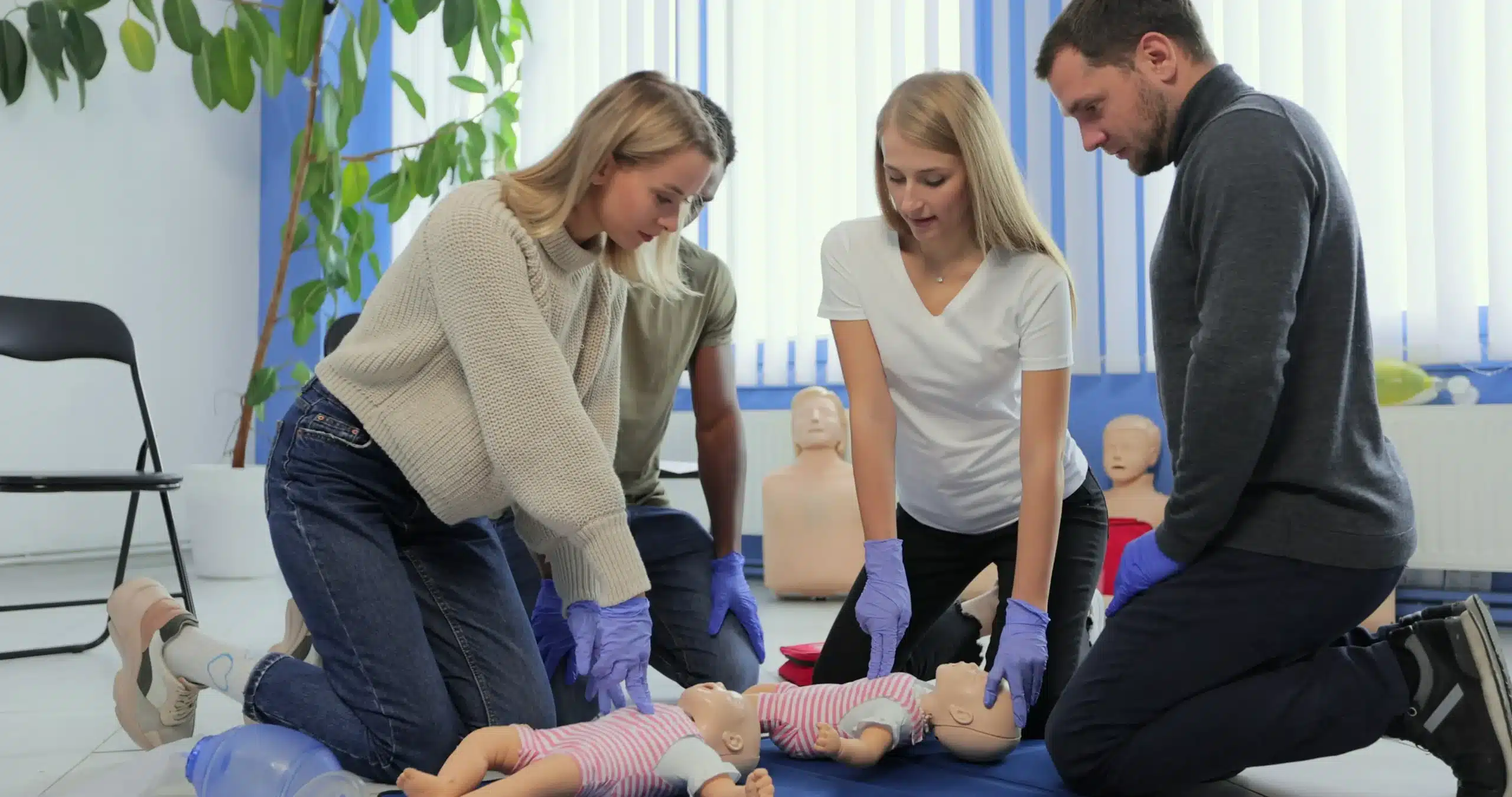In an emergency, seconds can matter. CPR can double or triple a person’s chance of survival during cardiac arrest. But where do you start if you want to learn this life-saving skill? This guide breaks down the process of finding and enrolling in cpr classes near me, focusing on options in Oakland, Alameda, and Berkeley, CA. We’ll cover everything from the basics of CPR to choosing the right course format and understanding certification requirements. We’ll also address common barriers to training, such as time constraints and cost concerns. Empower yourself with the knowledge and skills to act confidently in a crisis.
Key Takeaways
- CPR training fits your lifestyle: Choose from online, in-person, or blended learning formats to match your schedule and preferred learning style. Many providers offer flexible class times and locations.
- Credible certification matters: Select a training provider affiliated with a recognized organization like the American Heart Association or the American Red Cross. Verify instructor credentials and check for legitimate certifications.
- Local training strengthens communities: In-person classes provide hands-on practice and direct instructor feedback. Learning alongside neighbors builds a network of trained responders, improving community emergency preparedness.
What is CPR?
What is CPR?
Cardiopulmonary resuscitation (CPR) is a lifesaving technique used in medical emergencies, especially when someone’s breathing or heartbeat has stopped. This can happen due to a heart attack, near drowning, or other life-threatening situations. CPR combines chest compressions and rescue breaths to circulate oxygenated blood to the brain and other vital organs. It’s a critical bridge that keeps a person alive until professional medical help arrives. The field of CPR is constantly evolving, with ongoing research leading to improvements in training programs and techniques.
Why CPR Skills Matter
Learning CPR can empower you to make a real difference in a critical situation. Effective bystander CPR can double or triple survival rates in cardiac arrest cases. When someone trained in CPR is nearby, the response time to begin lifesaving measures is drastically reduced, significantly improving the victim’s chances of survival. Community CPR training programs build both the skills and the confidence to act quickly and effectively during emergencies. Learn how to get involved in your community’s CPR training. Having trained individuals within a community strengthens the chain of survival and creates a safer environment for everyone.
Find CPR Classes Near You
Finding the right CPR class can feel overwhelming, but it doesn’t have to be. This section breaks down the different types of classes available, so you can choose the best fit for your needs and location, including options in Oakland, Alameda, and Berkeley, CA. We’ll also cover how to find CPR classes near you.
In-Person CPR Classes
In-person CPR classes offer hands-on learning and direct interaction with an instructor. This format allows you to practice techniques on mannequins and receive immediate feedback, which is essential for developing proper form and confidence. The American Red Cross offers a variety of in-person CPR classes, including options for adults, children, and infants. These classes are typically held at various locations throughout your community, making them accessible to a wide range of people. For example, you can find in-person CPR classes in Hartford, CT, covering various certification levels. Safety Training Seminars also offers in-person classes in Oakland and over 60 other cities, providing convenient options for those seeking local training.
Online CPR Courses
Online CPR courses offer a flexible alternative to traditional in-person classes. They allow you to learn at your own pace and complete the coursework from anywhere with an internet connection. However, it’s crucial to choose a reputable provider that offers legitimate and reliable certification. Some online courses may be too short or lack the depth needed to prepare you for real-life emergencies, so do your research before enrolling. Make sure the course aligns with current guidelines and provides sufficient information on how to verify its credibility.
Blended Learning Options
Blended learning combines the convenience of online learning with the benefits of in-person instruction. You’ll typically complete the coursework online, then attend a shorter in-person session to practice skills and demonstrate competency. This approach offers flexibility for busy schedules while still providing the hands-on experience necessary for effective CPR. The Red Cross also offers blended learning CPR classes in various locations, allowing you to tailor your learning experience to your needs. This format is becoming increasingly popular as it accommodates different learning styles and offers a comprehensive approach to CPR training. Additionally, keep an eye out for emerging training methods like virtual reality (VR) options, which can make learning more engaging and accessible. Reading about future CPR trends can provide insights into these innovative approaches.
Find Reputable CPR Training
Finding the right CPR class is crucial, but so is ensuring your certification comes from a trustworthy source. A valid CPR certification can make all the difference in an emergency. Here’s how to find reputable CPR training:
Research Local Organizations
Before signing up for any CPR class—whether online, in person, or blended learning—do your homework on the organization offering the training. Look for established CPR providers in your area. Safety Training Seminars, for example, offers CPR courses in Oakland and over 60 other cities. Check if the organization is affiliated with a nationally recognized organization like the American Heart Association or the American Red Cross. These organizations uphold specific standards for CPR training. A quick online search can often reveal if an organization has a history of complaints or negative reviews.
Verify Certifications
It’s not enough for a company to say they offer CPR certification. You need to verify their certifications. Check if the organization and instructors are certified by a recognized body. For example, are the instructors certified American Heart Association BLS Instructors? Is the organization itself an authorized training center? This due diligence protects you from scams and ensures your certification is widely accepted. A valid certification demonstrates you’ve received high-quality training and gives you confidence in your skills.
Read Reviews
One of the best ways to gauge the quality of a CPR training provider is to see what other students say. Look for reviews and testimonials about their experiences. Did they find the instructors knowledgeable and engaging? Was the course content thorough? Were the materials helpful? Honest feedback from past students can give you valuable insights into the training experience. It can also alert you to any potential problems. Sites like Google, Yelp, and Facebook often have reviews of local businesses, including CPR training providers. Reading these reviews can help you make an informed decision.
CPR Class Costs
CPR certification is an investment in life-saving skills, and understanding the costs involved can help you plan for your training. Several factors influence the overall price, so let’s break down what you can expect.
Average CPR Course Prices
The cost of a CPR class varies depending on the type of course and your location. Basic bystander CPR classes typically range from $30 to $60. These courses focus on essential CPR techniques for adults, children, and infants. More advanced courses, such as those for healthcare providers, including ACLS certification, or those designed for aspiring instructors, can cost significantly more. Becoming a certified CPR instructor requires more extensive training, and the total investment can range from $1,300 to $5,100, according to Online CPR Certification.
Factors Affecting Costs
Several factors contribute to the overall cost of CPR training. The certifying organization plays a role, with different organizations having different fee structures. Programs through the American Heart Association or American Red Cross, for instance, may have varying price points. The type of equipment used in the class also affects the cost. High-quality manikins and AED trainers are essential for effective training, and their cost is factored into the course fees. Finally, the class location can influence pricing, as costs can differ between urban and rural areas or among various training centers. Safety Training Seminars offers a low price guarantee and group discounts to help make training more accessible.
Find Discounts
While CPR training is a valuable investment, there are ways to reduce the cost. Look for discounts offered by training organizations, such as those sometimes available through the American Red Cross. Some organizations may offer free or reduced-cost training in exchange for volunteer work. Inquire about group discounts, especially if you’re signing up with friends, family, or coworkers.
CPR Certification Process
Getting CPR certified is straightforward. Here’s what you can expect:
What Happens in Class?
CPR classes blend interactive lectures, demonstrations, and hands-on practice. You’ll learn to assess a situation, perform chest compressions, give rescue breaths, and use an automated external defibrillator (AED). Many courses, like those from the American Red Cross, cover CPR for adults and children. Some also include training for choking emergencies. Healthcare providers can find specialized courses covering primary assessments, ventilation techniques, and other advanced skills.
Exams and Assessments
Most CPR classes include a skills test. You’ll demonstrate your CPR technique to an instructor. After successfully completing the course and skills test, you’ll receive your CPR certification. This
How Long is Certification Valid?
CPR certifications are typically valid for two years. Staying current with the latest CPR guidelines is important, so renew your certification before it expires. Renewal courses are readily available and often shorter than the initial certification course, offering a refresher on essential skills and any updated guidelines.
Choose the Right CPR Class
Finding the right CPR class involves understanding your learning style, schedule, and certification requirements. Let’s break down each of these factors to help you make the best choice.
Assess Your Learning Style
CPR classes are offered in a few different formats. Think about which learning environment best suits you. Do you thrive in a structured, in-person setting? Or do you prefer the flexibility of online learning?
- In-Person Classes: These traditional classes provide hands-on training and direct interaction with an instructor. You’ll practice skills on mannequins and receive immediate feedback. For many, this in-person, hands-on experience is the most effective way to learn CPR. Our in-person CPR classes offer this valuable experience.
- Online CPR Courses: Online courses offer flexibility and convenience. You can learn at your own pace and complete the coursework from anywhere with an internet connection. However, online-only classes typically don’t include hands-on skill demonstrations, so you’ll need to supplement your learning.
- Blended Learning: This hybrid approach combines online coursework with an in-person skills session. You’ll cover the theoretical material online and then attend a shorter in-person session to practice your skills and receive instructor feedback. This can be a great option for those who want some flexibility but also value hands-on learning. The American Red Cross offers blended learning CPR courses.
Consider Your Schedule
Before you commit to a class, check the schedule and ensure it aligns with your availability. Some classes are offered on weekdays, while others are held on weekends or evenings. Think about your work commitments, family obligations, and other activities.
If you have a busy schedule, online courses might offer the flexibility you need. However, if you prefer in-person training, make sure the class times work for you. We offer a variety of CPR class schedules to accommodate different needs.
Meet Requirements
Different professions and organizations have specific CPR certification requirements. Make sure the class you choose meets the standards set by your employer, licensing board, or regulatory body. For example, healthcare providers often need certification from the American Heart Association. Our courses meet AHA requirements.
Also, remember that CPR certifications typically expire after two years. If your certification is nearing its expiration date, look for a renewal course. Renewal courses are often shorter and focus on refreshing your skills and knowledge. We offer CPR renewal courses as well.
Popular CPR Course Providers
Finding the right CPR course provider is a crucial step in your certification journey. Several respected organizations offer comprehensive training programs. Here’s a look at some popular choices:
Safety Training Seminars
Safety Training Seminars offers CPR and first aid training tailored to various organizations and individuals. Their focus is on equipping participants with practical skills to respond effectively in emergencies. They offer courses in over 60 cities, including convenient options for those seeking CPR certification in Oakland. Check their website for course schedules and locations. For those in the Oakland area, Safety Training Seminars offers a low-price guarantee and group discounts. They also provide American Heart Association certifications for courses such as BLS, ACLS, and NRP.
American Heart Association
The American Heart Association (AHA) is a leading provider of CPR training, with courses designed for both healthcare professionals and the general public. The AHA emphasizes hands-on practice and incorporates the latest guidelines in CPR and emergency cardiovascular care. Their certifications are widely recognized and respected. You can find AHA-certified courses through various training centers and hospitals.
American Red Cross
The American Red Cross provides CPR training classes, both online and in person. These courses teach essential life-saving skills, covering CPR for adults and children. Red Cross certification meets many professional requirements, including OSHA standards. Visit their website to locate a class near you.
National Safety Council
The National Safety Council (NSC) offers comprehensive CPR and first aid training programs designed to equip individuals with the skills to handle emergencies. Their courses are recognized across various industries and provide a solid foundation in first aid and CPR techniques. You can find NSC training centers through their website.
ProTrainings
ProTrainings offers a variety of CPR and first aid training courses catering to different audiences, from healthcare providers to the general public. Their online and blended learning options provide flexibility for those with busy schedules. Explore their website to find a course format that suits your needs.
Prepare for Your CPR Class
Getting ready for your CPR class isn’t complicated, but a little preparation can make your learning experience smoother. Here’s what you should know:
What to Bring
CPR classes often provide students with step-by-step guides to help them retain the skills they learn. Bring a notebook and pen, or a tablet or laptop to jot down notes. Your instructor may also require specific materials, so check with your chosen training center beforehand—for example, some instructors encourage students to purchase a CPR mask for hygienic practice during training.
Dress Code
CPR classes typically involve physical demonstrations and practice, so wear comfortable clothing that allows you to move freely. Think athletic wear or casual clothes that won’t restrict your movement. You’ll be practicing techniques on mannequins and working with partners, so comfortable clothing is key. The Red Cross emphasizes a relaxed learning environment, so focus on comfortable attire that lets you participate fully.
Pre-Course Study Materials
While not always mandatory, reviewing any pre-course materials provided by your chosen CPR training provider, like Safety Training Seminars, can give you a head start. Many organizations offer refresher materials and printable CPR steps to review before class. This can be especially helpful if you’re a beginner or want a refresher before your training. Before your class, it’s also a good idea to verify your instructor’s credentials to ensure you’re learning from a qualified professional. This step ensures you receive high-quality instruction and a recognized certification.
Benefits of Local CPR Training
Choosing a local CPR class offers distinct advantages. These benefits can significantly impact your learning and preparedness.
Hands-On Experience
Local CPR training excels at hands-on learning. Practicing on mannequins builds muscle memory and confidence. In-person CPR classes offer immediate feedback and correction, crucial for mastering chest compressions, rescue breaths, and other skills. The American Red Cross highlights that their CPR courses cover techniques for adults and children, providing well-rounded training. Many local providers, like Safety Training Seminars, offer blended learning, combining online coursework with in-person skills sessions for scheduling flexibility. This blended approach allows you to learn the basics online and then refine your technique with a qualified instructor.
Instructor Feedback
Direct interaction with an instructor is invaluable. Local classes provide real-time feedback, ensuring you perform CPR correctly. This personalized guidance addresses individual questions, leading to a deeper understanding. A relaxed classroom setting, like those offered by the American Red Cross at their various training locations, creates a comfortable learning environment. This encourages questions and allows for immediate clarification. Many instructors also offer ongoing support and refresher resources to help maintain your skills. This continued support ensures you remain confident and prepared for real-life scenarios.
Community Knowledge
Learning CPR alongside neighbors creates a network of trained responders. This community preparedness can make a real difference in emergencies. MyCPR NOW discusses how community involvement in CPR training expands its reach, including those who might not seek it independently. Building this network strengthens community resilience. MyCPR NOW also provides guidance on creating inclusive CPR programs, ensuring diverse groups access this life-saving training. This inclusivity strengthens the overall preparedness of your community.
Overcome CPR Training Barriers
Let’s be honest: learning CPR can feel intimidating. Maybe you’re worried about the time commitment, the cost, or even your own ability to perform CPR effectively. It’s totally normal to have these concerns. This section tackles common CPR training barriers and offers solutions to help you get certified.
Address Misconceptions
One of the biggest hurdles to CPR training is misinformation. Many people believe CPR alone can restart a heart, which simply isn’t true. CPR primarily keeps oxygenated blood flowing to the brain and other vital organs until professional medical help arrives. Another common misconception is that CPR is difficult to learn. In reality, CPR techniques are straightforward and designed for anyone to master. Even children can learn basic CPR! Understanding the facts about CPR can empower you to seek training with confidence. Dispelling these common CPR myths makes getting certified less daunting.
Manage Time and Costs
Time constraints and financial concerns often prevent people from pursuing CPR training. Fortunately, there are ways to make training more manageable. Online learning options offer flexibility for those with busy schedules, allowing you to learn at your own pace. Many organizations, including Safety Training Seminars, offer group discounts which can significantly reduce the cost. Check with local community centers or workplaces to see if they organize group training sessions. Remember, even a basic understanding of CPR is better than none. Assess your community’s needs and find a program that fits your budget.
Accessibility Solutions
CPR training should be accessible to everyone in the community. If traditional classroom settings pose challenges, explore alternative options. Some organizations offer mobile CPR workshops that bring the training directly to your location. This can be particularly helpful for community groups, businesses, or schools. Look for providers who prioritize inclusivity and offer training in multiple languages or adapted formats for people with disabilities. Creating inclusive CPR programs ensures that everyone has the opportunity to learn these lifesaving skills. Safety Training Seminars is committed to providing accessible and affordable CPR training in Oakland and surrounding areas. Contact us to learn more about our programs and how we can help you overcome any barriers to training.
Related Articles
- CPR Classes in Alameda: Your Complete Guide – Oakland CPR Classes
- CPR Certification in Oakland: Your Guide – Oakland CPR Classes
- CPR Classes in Oakland: Your Complete Guide – Oakland CPR Classes
- Why CPR is Crucial in Healthcare
- The Importance of Workplace CPR & First-Aid Training
Frequently Asked Questions
How do I choose between online and in-person CPR training?
Think about your learning style and schedule. If you prefer hands-on learning and direct interaction with an instructor, an in-person class is probably a better fit. If you need more flexibility, an online or blended learning course might be a good option. Blended learning combines online coursework with a shorter in-person skills session.
What does CPR certification cost, and are there ways to save money?
CPR class costs vary based on the course type, location, and training organization. Basic CPR classes typically range from $30 to $60, while more advanced courses can be more expensive. Look for discounts like group rates or check with local community centers for potential cost savings. Safety Training Seminars, for example, offers a low-price guarantee and group discounts.
How long is CPR certification valid, and how do I renew it?
CPR certifications are usually valid for two years. It’s important to renew your certification before it expires to stay up-to-date on the latest guidelines. Renewal courses are typically shorter than the initial certification course and offer a refresher on essential skills.
What are the benefits of getting CPR certified locally?
Local CPR training offers hands-on practice, direct feedback from instructors, and the chance to build a network of trained responders within your community. This can be especially valuable in emergency situations.
What if I’m nervous about learning CPR?
It’s completely normal to feel a little apprehensive about learning CPR. Many people worry about the time commitment, cost, or their ability to perform CPR effectively. Remember that even basic CPR knowledge can make a difference, and there are resources available to help you overcome any barriers to training. Flexible learning options and community-based programs can make learning CPR more accessible and less intimidating.


